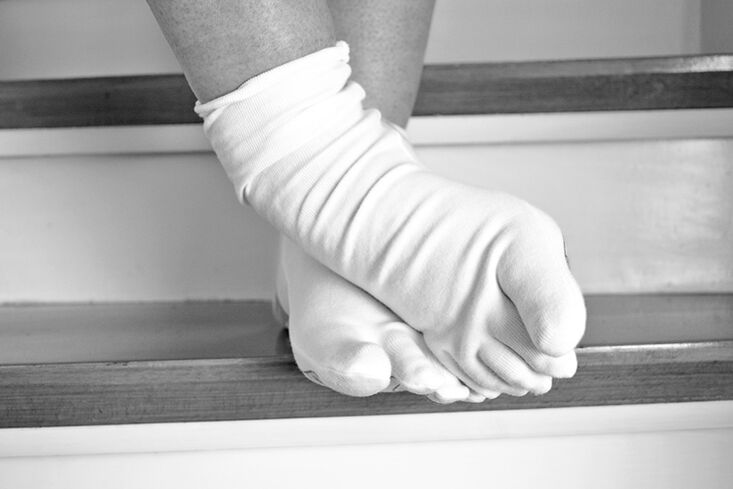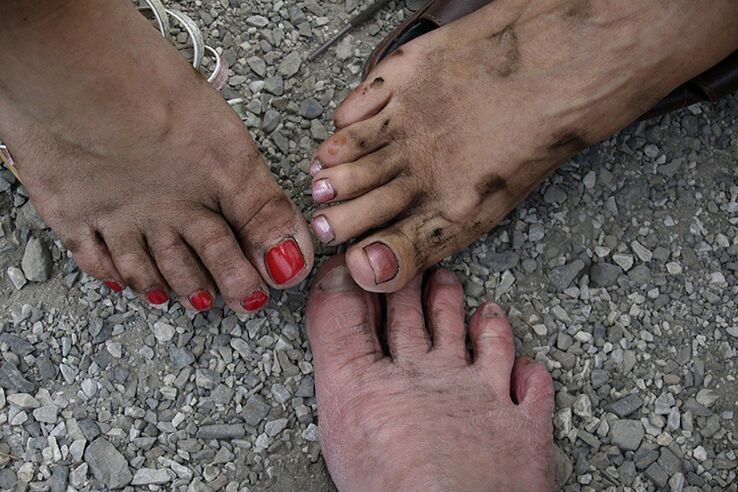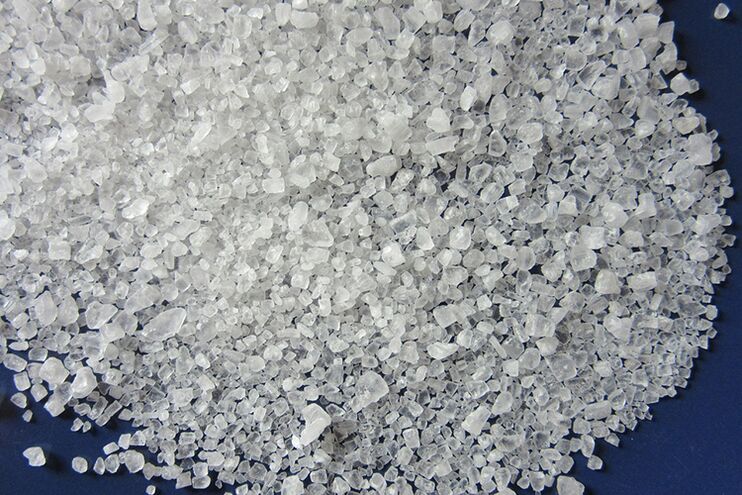Dermatomycosis is a common group of diseases. Patients do not always take them seriously, leading to advanced forms of pathology that are difficult to treat. Fortunately, there are many ways to eliminate fungal infections on the feet and eliminate nasty diseases such as fungal infections on the toes and feet.
Patients do not always take them seriously, leading to advanced forms of pathology that are difficult to treat. Fortunately, there are many ways to eliminate fungal infections on the feet and eliminate nasty diseases such as fungal infections on the toes and feet.
Dermatomycosis between the fingers-how does it happen?
Dermatomycosis is an infectious disease caused by fungus parasitic on the skin. They can appear anywhere on the body. However, they tend to choose skin folds. The space between the toes is their favorite place. This is due to the fact that the legs sweat a lot and there is no time for moisture to evaporate in tight shoes. Therefore, the space between the fingers is usually wet. These conditions are exactly what the fungus needs for reproduction. It is not uncommon for fungus to enter the dents between the fingers from an infected nail.
Promote the development of skin diseases:
- Inadequate foot hygiene, overheating or hypothermia;
- Sweat easily
- Poor blood circulation in the feet related to heart disease, smoking, and diabetes;
- pressure;
- Calluses and wounds on the skin of the feet;
- Lack of vitamins and minerals in the body (mainly zinc);
- Nutritional ulcers on the legs;
- Hormonal imbalance and thyroid disease;
- overweight;
- Excessively dry skin.
However, in most cases, if the person has healthy immunity, the fungus between the toes will not develop.
Due to the frequent wearing of tight-fitting shoes, this disease is more common in men. The fungus on the legs can appear not only in adults, but also in children.
In 90% of cases, dermatomycosis between the toes is caused by the activity of three dermatophytes-Trichophyton, Microsporum, and Epidermal fungi. Moreover, the skin of the interdigital space is often affected by Candida fungi.
Most commonly, the infection initially develops in the cavity between the two smallest toes. However, other interdigital spacing may also be affected. Once the fungus enters the skin, it will actively multiply on it. The stratum corneum residues of the skin can be used as food for microorganisms.
Skin infections can spread from person to person. For this, a simple contact of the skin of the foot with the surface containing the fungus is sufficient. With the help of other people's shoes, socks, shared towels, and wet floors in the shower room, pathogens may be spread. Personal hygiene must be carefully monitored and only personal items used. In swimming pools, showers, bathtubs and saunas, personal or disposable slippers and flip-flops should be used.

Usually, skin diseases are transmitted from one family member to another by using the same shoes, pedicures, socks, towels, walking barefoot and other items in the house.
Symptoms of a fungal infection on the skin of the feet.
Early symptoms of foot mycosis:
- Itching and burning, worsening at night;
- dry
- Skin peeling
- Small cracks.
As the disease progresses, symptoms intensify, itching and burning become unbearable, causing skin scratching and irritation, and cracks becoming deeper. The skin of the feet becomes rough. Pain, unpleasant smell will not disappear even after washing, swelling and congestion, and the epidermis will fall off.
Then bubbles filled with slurry appeared. After opening them, ulcers that cannot heal still remain on the skin. Bacterial bacterial infection.
Peeling nails and abscesses may appear. Complications of foot mycosis may be the penetration of the fungus into the blood and the spread of the infection throughout the body. At the same time, body temperature rises. Gangrene lesions of the feet may also develop. Cardiovascular diseases, immunodeficiency states and diabetes complicate the progression of skin diseases.
To diagnose mycosis of the feet, the doctor may not be enough to examine the skin. It is usually necessary to analyze the composition of the skin flora. To do this, scrape from the affected area. Even if there are no obvious symptoms of infection, fungus can be found on the skin.
There is also a popular method of determining the presence of fungus on the legs. To do this, you need to put your feet in a potassium permanganate bath. If there is no fungus on the skin, it will turn pink and the affected area will turn white.
How to remove the fungus between the toes?
It is easy to get an infection on the skin, but it is much more difficult to get rid of the infection. Dermatomycosis is always treated at home, but this does not mean that completely independent treatment will definitely help the patient. In any case, a doctor’s consultation is required.
There are many antifungal drugs that can effectively kill fungi. However, the success of treatment largely depends on the stage of the disease. If she goes too far, it will be difficult to get rid of the infection. In the initial stage, external antifungal drugs are used. If the disease is already spreading, then the doctor recommends systemic treatment. Most commonly, terbinafine, itraconazole, and fluconazole are prescribed in tablet form.
Popular antifungal agents:
- Nystatin,
- Fluconazole
- Ketoconazole
- Clotrimazole,
- Terbinafine
- Naftifine
- Miconazole
- Itraconazole
- Natamycin.
Some antifungal creams also contain anti-inflammatory ingredients.
All ointments are applied in the same way-they must be applied to the affected area of thin skin regularly. Some ointments are enough to be used once a day, others need to be used more frequently. Antifungal sprays that can be sprayed onto the affected area are more convenient than ointments.
Treatment with antifungal ointment can be very long. After 2 weeks, certain types of ointments can eliminate the infection. But if it is severely damaged, the treatment time may be as long as 3 months. The doctor recommends using the ointment at least 2 weeks after the obvious symptoms of the disease disappear. Once every six months, it is necessary to use ointment to lubricate the toes just in case.
Similarly, in the case of severe infections, systemic antifungal drugs can be used. However, they have many contraindications and side effects. In particular, pregnant women should not use fungal pills. In addition, many skin ointments are prohibited during pregnancy. If you need to use such topical preparations, you must consult a doctor. Not all drugs are allowed to be used in childhood. Therefore, you need to review the description of the selected tool. Some medicines can be used from 2 years old, while others can be used from 12 years old.
The expert should choose the right medicine. Incorrect use of antifungal drugs not only cannot reduce the pathogenic microorganisms in the patient, but may also lead to drug resistance (especially if the patient is constantly reinfected). Toxins secreted by many fungi can suppress local immunity, which helps to further develop infections.
In addition, vitamin and mineral complexes are also taken. If the disease is complicated by bacterial infection, the doctor will prescribe antibiotics, but if there are signs of allergies, antihistamines should be prescribed. Treatment can be supplemented with anti-inflammatory ointments, salicylic acid, sulfuric acid, fish oil and zinc ointments.
Salicylic acid ointment:
- Has anti-corrosion properties,
- Prevent skin keratinization,
- Promote the recovery of the epidermis,
- Prevent the spread of infection.
Zinc ointment contains lanolin, menthol, and zinc oxide. Zinc ointment has a disinfecting effect, promotes skin regeneration, and relieves itching and burning.
Sulfur ointment has anti-inflammatory, moisturizing and disinfecting effects. Muskol ointment has keratin-dissolving, anti-inflammatory and bactericidal effects. Similarly, fish oil phenol ointment promotes tissue regeneration.
Don't forget to clean your feet. It is necessary to give up tight, uncomfortable shoes, synthetic socks and stockings, and replace the insoles regularly. Shoes must be disinfected with anti-fungal spray. Indeed, if the patient’s skin is constantly infected with new parts of the fungus living in the shoes, the treatment will not have any effect.
Fungus between the toes: using folk remedies for treatment at home
Treatment with pharmaceutical preparations does not always bring the desired results. Therefore, people turn to folk remedies. This method is also understandable, because many synthetic antifungal ointments and sprays are by no means cheap. Folk remedies can be used as an auxiliary treatment for skin ointments in pharmacies.
The simplest folk remedies for removing fungi are salt and soda water. To prepare the tray, you need 2-3 tablespoons of salt or soda per 5 liters. water. The water temperature is -+40-45°C and the duration of the process is 15-20 minutes.

One of the best home remedies is herbal baths with antiseptic properties. It could be chamomile, sage, marigold, nettle, St. John's wort. To prepare for the bath, you need 2-3 tablespoons. Plant materials (you can mix various herbs) stick to a cup of boiling water, filter and add water to a 5-liter container for bathing. The water should be warm, but it should not burn the skin of the feet. The duration of this process is 15-20 minutes.
Bathing with potassium permanganate solution can also help many people have fungal infections on the skin of their feet. To prepare a light pink solution, only a few tablets of potassium permanganate are needed. You can also moisten the cotton wool with potassium permanganate solution and stick it between your fingers.
Boric acid is also effective in treating the disease. You can use liquid boric acid and powder at the same time. The acid can be added to the bath and treated with the affected area.
For the tray, you can also use a slightly heated 9% cider vinegar solution. The duration of this process is 15 minutes. You can also make vinegar emulsion.
Another recipe is an iodine bath. To prepare the solution, just dilute 20 drops in 3 warm water. The duration of the procedure is 15 minutes, and the treatment course is 2-3 weeks.
After the water procedure is over, it is necessary to clean the keratin and flaky tissue of the skin. It is recommended to take a bath at least once a day, preferably at night.
In addition, to treat fungal diseases of the feet, garlic ointment, pharmacy anti-dandruff shampoo with antifungal ingredients, chlorhexidine and hydrogen peroxide lotion can be used.
Prevent toe skin mycosis
The disease occurred due to non-compliance with personal hygiene rules. Therefore, it is necessary:
- Don't use other people's pedicure tools, towels, slippers, socks and shoes, and don't let strangers use their shoes, socks, hygiene products;
- Observe the hygiene of the feet, wash the skin with soap every day, and carefully handle the space between the fingers;
- Trim your toenails regularly;
- Wear comfortable shoes and socks made of breathable fabric;
- Change socks regularly and wash them at a temperature of at least +40°С;
- Exercise to improve blood circulation in your legs.
What is the fastest treatment?
It is impossible to say clearly which remedy is the fastest and best. After all, the effectiveness of treating skin fungal diseases depends on many conditions-the severity of the pathology, the level of immunity, and the presence of the accompanying disease. Some patients can get help through traditional methods, while others can get help through medicated ointments. It is important not to start the onset and start treatment at the first symptom of the disease. It is also important to identify the type of pathogen. For this, you need to see a doctor. Maybe he will be able to find the best option for this medicine.
























